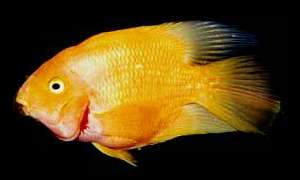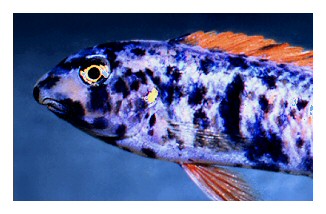The creation (deliberate or accidental) of hybrids is an important and controversial issue with
cichlid aquarists. Here are my views.
Quite frequently, an aquarist will write me to describe how two of his or her cichlids have spawned,
but the surprising thing is that the aquarist thought the fish were two different species.
The question typically goes something like this: “My male species 1 just spawned with
my female species 2. Have you ever heard of this, and what should I do to raise the kids?”
Other variants include “Will I get rich selling these?” and “What would be their proper name?”
These questions raise some interesting and deep philosophical and ethical questions. I will
address these issues by trying to answer some of the specific questions.
First, some terms. “Hybrid” refers to the result of mating a male of one species with a female of
another species. We often call this “crossing” two species.
1. Have I ever heard of this before?
This is easy to answer. Yes I have. Hybrids are quite common in the cichlid hobby. Almost any
Central American cichlid will hybridize with any other. Many of the mbuna (rock dwelling cichlids
from Lake Malawi) will hybridize with each other. I have even heard of a mouthbrooder hybridizing
with a substrate-spawning cichlid. So, hybridization is not rare.
2. Does this occur in the wild?
This is difficult to support with data, but from my observations in the field in Central America, and
from what I have read and heard from fellow cichlid researchers working elsewhere, hybrids are
very rare in the wild. Surprisingly, two species of fishes which together in the wild will not
hybridize, will do so in an aquarium quite readily.
3. Will I get rich producing hybrids?
No. In fact, you will find that most advanced cichlid hobbyists have an active dislike for hybrids (and
to be honest, for the people that produce them).
Every now and then someone produces a new “wonder” fish by hybridizing two species and they
may even sell some. In the end, however, this person usually finds themselves shunned by the rest
of the cichlid aquarist community and worse yet, the person gets a bad reputation even if they stop
producing hybrids: their future actions are always suspect. A bad reputation is an extremely
difficult thing to change.
4. What is the proper scientific name of a hybrid?
Hybrids do not get a new scientific name, in other words, you cannot create a new species by
hybridization in your fish tank.
If you crossed a Texas cichlid, Herichthys cyanoguttatus with a convict, Archocentrus
nigrofasciatus, the most correct name to use would be Hericthys cyanoguttatus
× Archocentrus nigrofasciatus, i.e. the two names joined by
a ×.
For those who are really up on their biology, what I have said here is only partly true. We now know
that many species of plants in the wild, and potentially some animals as well, are actually the result
of hybridization in the wild. However, as far as we know at this point, this has not occurred with
cichlids in the wild.
5. Why are hybrids so bad?
Hybrids are bad for several reasons at many different levels.
At a philosophical level, many people dislike hybrids because the creation of hybrids is a kind of
arrogance on behalf of people, namely some sort of deep-rooted feeling that we can improve upon
nature. These people, myself included, feel that with 1500+ species of cichlids in the wild, we don’t
need to go creating yet another kind just because we can. Furthermore, the ability to create
“designer” organisms has a way of cheapening the beauty and wonder of real organisms.
On a very practical level, hybrids create enormous problems for fellow fish-keepers, problems that
may last for a long time and become intractable. Imagine you cross (make a hybrid) between two
species of Central American cichlid, e.g. a convict and a Texas cichlid. You know they are hybrids
and you keep them in a tank separate from other cichlids. But over time, events cause this tightly
controlled situation to get out of hand.
One of the hybrids may jump into another tank (this happens quite often; ask anyone who
maintains a large fish room).
You might sell or give away some of the hybrids and the recipient may not know or remember that
the fish is in fact a hybrid. People often bring fish back to pet stores or sell them at auctions and so
the hybrid nature of the fish can easily get lost along the way.
The first generation of hybrids (called F1 hybrids) are often easy to spot; they look like a mixture of
the two parent species. If two of these F1 hybrids go on to mate, or if one of them is mated to
either of the parent species, the offspring (F2 hybrids) create the real problems. Why? Because
F2 individuals may look like almost anything in between the two parent species, up to and
including looking like either of the parent species. This is a disaster waiting to happen because it
means that now you have a fish that looks like a certain species but doesn’t have all the right
genes for that species.
Now imagine what happens when these offspring grow up and get back into the mainstream of the
hobby. A person (potentially you) buys what looks like a convict cichlid at your local pet store. You
are unaware that the fish is actually an F2 convict × Texas cross brought in a week ago by
someone else. The person who sold the fish to the store forgot to mention that point (we will
assume they forgot accidentally, but since most reputable pet stores will not knowingly carry
hybrids, some people “forget” to mention that the fish are hybrids since they look like convicts
anyway).
Now you put your new convict in with your other convict and for some strange reason, they never
reproduce successfully. Or they do reproduce and the kids look kind of strange. Now you have a
bunch more hybrids that you have to deal with.
6. Dealing with hybrids
The solution here is simple. Destroy them immediately. If you have a difficult time killing a bunch of
hybrid eggs, imagine how difficult it will be for you to kill them when they are cute little fry or even
young adults. This is a responsibility you take on when you keep fish and you should take it
seriously.
Under absolutely no circumstances should you pass hybrids to someone else unless they are to be
used as feeder fish.
7. How can I avoid getting hybrids?
Probably the best way to avoid getting hybrids in the first place is to purchase your fish from a
reputable dealer and avoid buying fish from a tank labelled “Mixed African Cichlids.” The latter is
usually a telltale sign that the dealer doesn’t know what the fish actually are.
Conclusion
Avoid hybrids.
I find it incredibly reassuring that cichlid hobbyists have taken and do continue to take such
a strong stance against hybrids. This is not the case in many other animal-related fields.
Because of this attitude amongst cichlid keepers, you can go into a pet store in most any part
of the world and be reasonably assured that the cichlid you are buying and bringing home is in
fact a representative of a real cichlid species. That is truly remarkable.


 “The value of the Flower Horn is from the ‘nuchal hump’ on its head [1], the pearl dots on its
body, the redness of its fins and body and the roundness of the body on the whole [2]. In order to
get the hump on the head to a reasonable size, one can place a mirror near the aquarium in
order to get the fish excited. Looking at the mirror is like it is facing another fish and since this
species is territorial in nature it will try to chase the mirror image away. Through this method the
‘nuchal hump’ on the head can get bigger and the colour of the fish itself will brighten up [3]. It
is also advisable to put in small stones preferably coloured stones in the aquarium. Playing with
the stones is another kind of stimulation which can enhance the ‘hump’ on its head [4].”
“The value of the Flower Horn is from the ‘nuchal hump’ on its head [1], the pearl dots on its
body, the redness of its fins and body and the roundness of the body on the whole [2]. In order to
get the hump on the head to a reasonable size, one can place a mirror near the aquarium in
order to get the fish excited. Looking at the mirror is like it is facing another fish and since this
species is territorial in nature it will try to chase the mirror image away. Through this method the
‘nuchal hump’ on the head can get bigger and the colour of the fish itself will brighten up [3]. It
is also advisable to put in small stones preferably coloured stones in the aquarium. Playing with
the stones is another kind of stimulation which can enhance the ‘hump’ on its head [4].”

